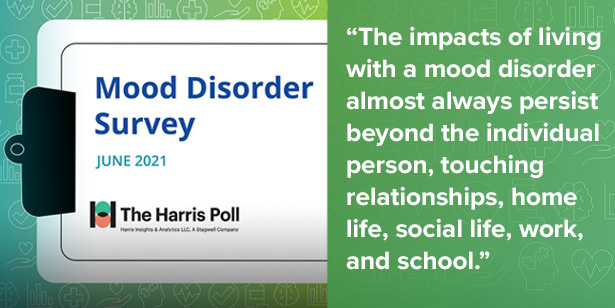Key Findings
Despite an overall sentiment of understanding and agreement that mental health recently has become more of a health care priority, and the openness of many adults about mental health since the pandemic started, there is a need to expand access to treatment, educate about mood disorders, reduce stigma and close gaps when it comes to mental health care.
- Most adults understand that mood disorders have significant economic and social impacts when left untreated, but access and cost are still major barriers to treatment.
- Most adults understand that mental health challenges can affect anyone, but misperceptions can lead to unfounded fears.
- Misperceptions may cause those with a mood disorder to struggle opening up to others.
- The pandemic has led many to be more open with others about their mental health, but this does not always translate to better outcomes – people of color are less likely to say they are coping well with changes to everyday life during the pandemic compared to white respondents, despite being more open about their mental health.
Living With A Mood Disorder
People diagnosed with a mood disorder experience symptoms and impacts in a variety of ways. These impacts have a particularly strong effect on relationships, with many participants reporting that their diagnosis affects how they are treated by others, which may lead them to feel misunderstood.
- The most commonly reported symptoms are changes in sleeping habits or feeling tired and low energy (51%), feeling excessively sad or low (42%) and excessive worrying or fear (39%).
- 50% of participants with a mood disorder reported experiencing negative impacts on personal relationships.
- 61% reported that people treat them differently after they learn of their diagnosis.
- 76% reported that people don’t understand what it’s like to live with a mood disorder every day.
Treatment And Support
Adults with a mood disorder see a wide range of treatment options – including medication, therapy, and peer support – as helpful, though most say trying to find the right option is frustrating. Lack of information about eligibility and high cost prevent access to treatment and support. In addition to formal treatment, complementary approaches like supportive personal relationships are seen as key to the recovery process.
- Non-pharmacologic treatments—like complementary health approaches (83%), psychotherapy (80%), and guidance and support from other people with lived experience (80%)—are seen as just as helpful as routine/maintenance psychiatric medication (81%) by those who have used them, even though routine/maintenance psychiatric medication is by far the most common treatment (48% currently using and 75% ever used).
- 78% of participants with a mood disorder say it’s frustrating trying to find the right treatment.
- Financial support from the government (24% currently receive and 37% ever received) and financial or practical support from family or friends (21% currently receive and 45% ever received) are the most commonly reported supportive services.
- The top barriers to receiving desired supportive services are being unsure of eligibility (48%), cost (41%) and being unsure about how to access the service (39%).
- Fortunately, the approach most commonly reported as helpful in the management of mood disorders and recovery — supportive personal relationships — are not limited by issues of cost or insurance coverage.
General Perceptions Of Mood Disorders
The public seems to understand some of the impacts of living with a mood disorder and the long recovery process, but some common misconceptions persist.
- 86% of participants in the public know mood disorders can significantly interfere with thoughts, behavior, activity and physical health, but many have an inaccurate understanding of specific symptoms.
- 70% of participants understand that treatment for mood disorders may be slow and not always work, but it can be very helpful for many people. 92% say most individuals with mood disorders could be helped if they received proper treatment.
- 70% know mood disorders can affect a person for their whole life, even if they get treatment.
- Despite that knowledge, 27% of participants in the public believe that individuals with a mood disorder could just “snap out of it” if they tried – improving their symptoms without any formal treatment or support.
Mental Health Today
The COVID-19 pandemic posed new challenges to mental health, but it has also increased openness. It also spurred the rise of telehealth, which may help mitigate access issues and close the gap in support.
- 47% of participants in the public reported experiencing symptoms of a mood disorder within the last two weeks.
- 39% say they coped very well with changes to everyday life during the pandemic.
- 52% say they have been more open with others about their mental health since the pandemic started.
- 30% say they are unable to get the support they need for their mental health during the pandemic.
- 61% of people diagnosed with a mood disorder have used telehealth for treatment. Of those, 83% are satisfied using telehealth and 79% say it has made it easier for them to access care.
Resources
- Mood Disorder Survey Report White Paper
- Infographic: Break the Silence on Mood Disorders: Countering Stigma with Openness and Understanding
- Infographic: Break the Silence on Mood Disorders: Countering Stigma & Cultural Barriers with Openness & Understanding
- Infographic: Break the Silence on Mood Disorders: Countering Stigma Experienced by Young Adults with Openness & Understanding
- Infographic: Break the Silence on Mood Disorders: Provide Respect & Support to Caregivers
- Press Release: Survey Finds Treatment Cost and Stigma Are Major Barriers to Accessing Care for Mood Disorders
- Press Release: Communities of Color Face Greater Challenges Finding Effective Therapy, National Survey Finds
- Press Release: Young Adults with Mood Disorders Often Not Receiving Mental Health Care, Survey Finds
Thank you to our partners who helped support our 2021 National Mood Disorder Survey to better understand the experiences of people with mood disorders and their family members.


